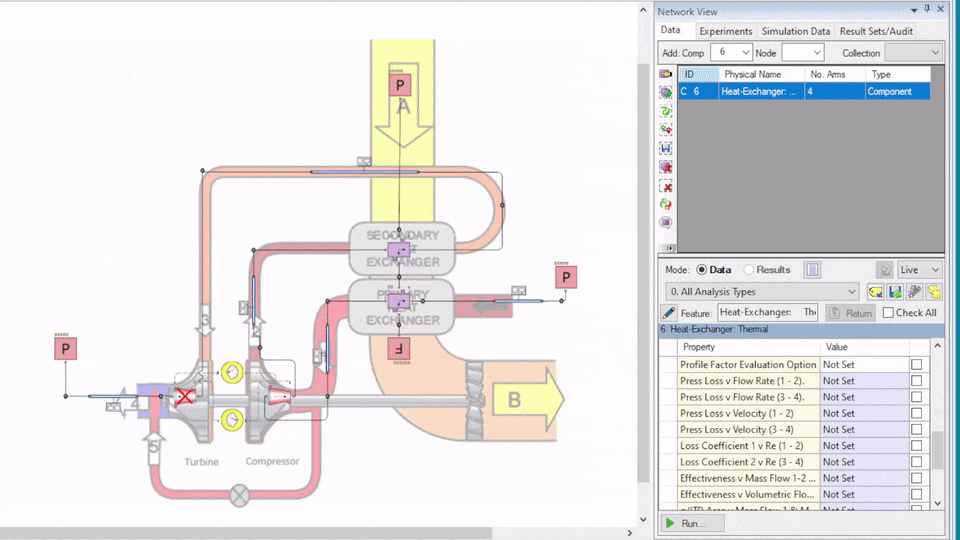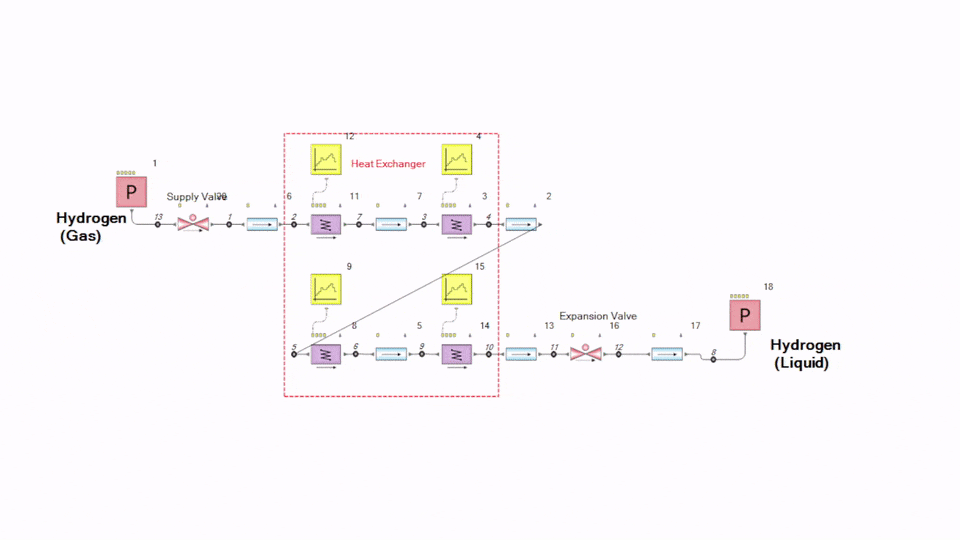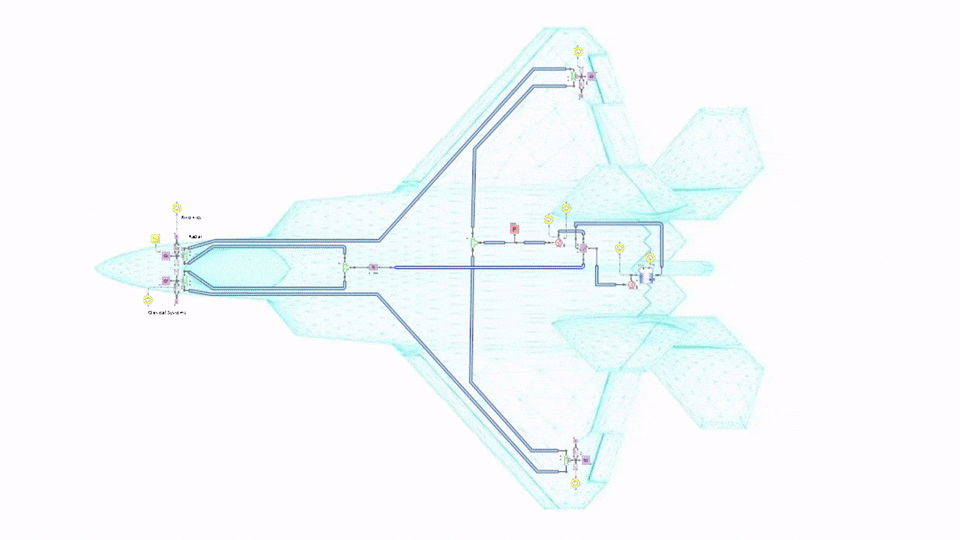Thermofluid Dynamic Systems
Thermofluid dynamic systems are those involving the transfer of thermal energy and the transport of fluids through pipes and equipment. They are widely used in a variety of industrial applications, such as power generation, refrigeration, heating systems, vehicles, chemical industry, aerospace industry, oil and gas industry, among others.
The main advantage of using a thermofluid dynamic analysis is the possibility of predicting the one-dimensional (1D) behavior of a piping system under different conditions, which can be very useful in optimizing performance. In addition, this approach allows for accurate computer simulations to be carried out, which can be very useful in decision-making and in the design of new facilities. This can lead to an improvement in energy efficiency, a reduction in operating costs and even increased facility safety.






Power generation
HVAC
Chemical industry
Automotive industry
Aerospace Industry
Oil and Gas Industry
They are fundamental for designing and optimizing large complex power generation systems. They make it possible to study and evaluate the performance of different applications, such as hydroelectric, thermoelectric, geothermal plants, solar plants of various types, steam production, boilers, thermodynamic cycles, thermal machines, pumping, heat exchangers, cooling towers, reservoirs and storage. thermal. This helps design and optimize these systems more quickly and efficiently, and facilitates innovation and sustainability. With the simulators, it is possible to evaluate the best options and optimize global performance, reducing costs and improving energy efficiency.
Allow HVAC designers and engineers to evaluate the performance of HVAC systems prior to construction. They are valuable tools for sizing, equipment selection and balancing of complex piping networks, optimizing energy consumption and operational stability. In addition, simulators also help to design innovative HVAC systems, meeting established sustainability goals, evaluating alternatives and simulating critical scenarios, making the project more intelligent and efficient, both in terms of implementation and operation costs.
They are used in all stages of the transformation process of a chemical industry. They are useful for the design, optimization and control of chemical processes, and can be used to improve mixing of reagents and find optimal operating conditions to improve reaction kinetics and increase conversion of reactants to products. Furthermore, these tools can also be used to simulate critical scenarios and test different conditions before implementing changes in production, which ensures process safety and efficiency. They can also be used to optimize resource utilization and minimize operating costs. The use of simulators also allows the innovation of new processes and projects, helping the chemical industry to remain competitive.
Necessary for designing and optimizing combustion, lubrication, cooling and other systems. They allow you to evaluate different design options, identifying potential problems before mass production, allowing you to implement solutions and choose those that offer the best performance in the most efficient way. Furthermore, these simulations can also be used to optimize energy efficiency, minimize costs and improve vehicle safety. The use of simulators is an important tool for the automotive industry, as it allows the development of new projects and technologies, helping to maintain competitiveness in the market.
The aerospace industry uses simulation tools to design, optimize and predict problems in aeronautical systems such as propulsion, climate control, refrigeration, cooling and armament. These tools make it possible to evaluate different design options and identify potential problems before mass production, ensuring the safety and efficiency of aerospace devices and allowing the innovation of new designs and technologies. They also make it possible to predict the need to replace devices before failures occur and optimize overall performance, in addition to minimizing operating costs.
They assist engineers in the design, equipment sizing, optimization and control of important processes such as fluid transport, heat transfer, refining, chemical reactions and energy production. This allows for energy integration of plant streams and increases production yields, as well as reducing operating costs and increasing safety. The simulations also make it possible to identify and prevent failures in the process, extending the useful life of the equipment and preventing failures that cause the plant to stop unexpectedly. In addition, operators can use these tools to train industrial plant control, ensuring process safety and efficiency.
Simcenter Flomaster is an advanced simulation tool for the design and operation of 1D thermofluid dynamic systems such as piping systems. It allows you to create detailed virtual models of systems of any scale and complexity, including piping, pumps, valves, heat exchangers and other components. With this tool, it is possible to simulate the operation of the system under different conditions, evaluate the performance in terms of flow, pressure, temperature and other variables, and simulate dynamic/transient events, such as failures or emergencies, to assess the system's safety and take Preventive measures.
Simcenter Flomaster can also be integrated with other tools and platforms such as PLM, CAD, Simulation and Industrial IoT, which facilitates decision-making and implementation of system improvements. It also allows you to create a detailed digital model of the system and reuse it during operation for virtual monitoring and online sensors, which increases efficiency and ensures system security. In summary, it is a fundamental tool to create and use digital twins of processes, guaranteeing efficiency and operational security.
Simcenter FLOEFD is an advanced 3D CFD (computational fluid dynamics) tool that allows designers to explore the potential of their ideas directly in their CAD software. It is capable of simulating the impact of changes to geometry or boundary conditions quickly and easily, enabling frequent "what if" analysis. In addition, Simcenter FLOEFD generates detailed reports within the CAD platform chosen by the user.
When integrated with Simcenter Flomaster, this software allows the generation of reduced order models that can be included as additional components to the flowchart, improving the accuracy of the simulations of the processes under study and allowing a more detailed and accurate analysis of the system's performance. The combination of Simcenter FLOEFD and Simcenter Flomaster allows obtaining a complete and accurate view of the operation of a process and making more assertive decisions about the design and operation of the analyzed system.